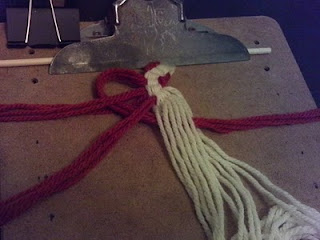
Luann's $3.50 Rectangle Loom - picture & text used by permission
(click picture for larger image)
I wanted to share this picture I received from Hand Prepared Fibers on yahoogroups
http://groups.yahoo.com/group/handpreparedfibers/message/38741
Luann says: This is what I have been doing today. I made a loom. The nails are 1/4 inch a part and it measure 32 x 16 inches. Not sure how big the piece will be when I take it off but I am hoping putting them together will make a nice table runner or maybe place mats. Rae, thank you so much for helping me with the dimensions on it. It's going to come out just right without adding the 1 extra nail. Don't ask me why.
I got a window at a yard sale for $1 and took out the glass and them trimmed one side with a table saw to even the sides. My husband did that for me. Then I stained it with walnut and the clear stuff. I wasn't sure I could do it or not but it came out right to my surprise. That's a lot of nails but I used a 1/16th inch Dremel tool (drill) to get the nail started so the wood wouldn't split.
The nails were $2.50 and I used all of them. Had the other stuff like a little 1/16th inch drill, hammer, stain, and that clear stuff you spray on the stain. I did all the staining the other day. So today all I had to do was put in the nails.
They are 1 inch finishing or panel nails. They have little ridges on them. They are black and you get them in a package in the hardware store. They come in other sizes too so be sure to get the 1 inch. The stand is also a handmade loom. I got it and a 7 foot tri loom for $100 a few years ago. - Luann
Thank you Luann!
Rectangle loom weaving and triangle loom weaving are generally done as continuous yarn weaving. It's a straightforward weaving technique that is often done with one yarn rather than separate warp and weft yarns. You can take the woven triangles or rectangles and sew them together to make larger pieces like shawls or table runners. Or you can make a larger loom and do one bigger piece.
Note: Panel nails come in different colors. I have seen comments recommending the use of black and white nails alternately to help keep track of warping. I will probably do that when I make one of these looms.
You can find files on making and using triangle and rectangle looms on the TriLoom yahoogroup
http://groups.yahoo.com/group/TriLoom/files/
You will have to join the above yahoogroups to see messages and files. To reduce spam, memberships have to be approved, but usually they are approved promptly. There is no charge to use those yahoogroups.
Or you can search for "triangle looms" and get a ton of hits.
Thank you again Luann for sharing that picture and info. $3.50 for a loom fits a lot of our budgets!
The nails were $2.50 and I used all of them. Had the other stuff like a little 1/16th inch drill, hammer, stain, and that clear stuff you spray on the stain. I did all the staining the other day. So today all I had to do was put in the nails.
They are 1 inch finishing or panel nails. They have little ridges on them. They are black and you get them in a package in the hardware store. They come in other sizes too so be sure to get the 1 inch. The stand is also a handmade loom. I got it and a 7 foot tri loom for $100 a few years ago. - Luann
Thank you Luann!
Rectangle loom weaving and triangle loom weaving are generally done as continuous yarn weaving. It's a straightforward weaving technique that is often done with one yarn rather than separate warp and weft yarns. You can take the woven triangles or rectangles and sew them together to make larger pieces like shawls or table runners. Or you can make a larger loom and do one bigger piece.
Note: Panel nails come in different colors. I have seen comments recommending the use of black and white nails alternately to help keep track of warping. I will probably do that when I make one of these looms.
You can find files on making and using triangle and rectangle looms on the TriLoom yahoogroup
http://groups.yahoo.com/group/TriLoom/files/
You will have to join the above yahoogroups to see messages and files. To reduce spam, memberships have to be approved, but usually they are approved promptly. There is no charge to use those yahoogroups.
Or you can search for "triangle looms" and get a ton of hits.
Thank you again Luann for sharing that picture and info. $3.50 for a loom fits a lot of our budgets!
Have a good day!





















